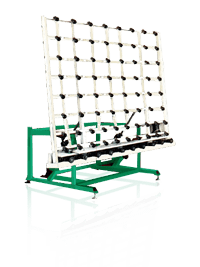Features
- Introduction
- Hghlights
- Options
Options
Large & Small Glass
Some facade are total glazing. This type of insulated glass is made of one large piece of exterior glass and one small interior glass. With optional sophisticated mechanism, these two glass panes can be aligned in center inside panel prior to pressing.
Multiple Insulated Glass
- Software and logic of standard line are program for double glazing. Triple or multiple glazing could be achieved by repeating positioning and panel pressing processes.
- After first two glass panes are pressed, front panel sucks and lifts up double glazing away from rear panel. Meanwhile, third glass, after inspected, arrives right next to panel press. After butyl coated aluminium spacer frame is applied on third glass with the help of spacer frame position system, glass floats and moves on rear panel air bed until it arrives exactly in the position that prior glass arrives. While vacuum is still kept on, rear panel brings double glazing towards third glass until they are pressed.
- If more glass is required, cycle is repeated. When multi-insulated glass is well pressed, it leaves panel press onto exit conveyor.
Low-E Glass Washing
- The last cylindrical brush is substituted with fine soft Nylon bristles. All other cylindrical brushes remain unchanged.
- All other cylindrical brushes would lift up during low-e glass washing to avoid hard brush from scratching low-e coating.
- A low-e coating detector is equipped. When glass is low-e, the detector would send a signal to lift up hard brush. If low-e glass is incorrectly loaded with coating surface facing leaning rollers, detector would send signal to stop the machine.
Tilting Unloading Table

- This table is a substitution of exit conveyor.
- It is a metal structure with freely moved caster balls. It could be tilted from vertical to horizontal or vice versa pneumatically.
- Insulated glass exits from rollers press and arrives at this table when it is in vertical position. After inspection, table is tilted horizontally. Semi-finished insulated glass is unloaded for subsequent secondary or final seal. It is then tilted up vertically and is ready to accept next glass.